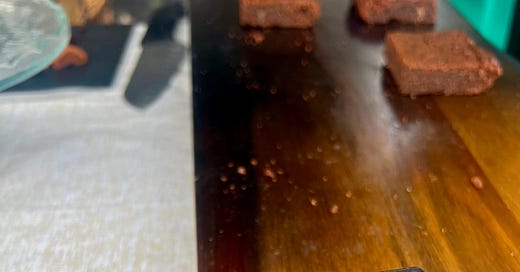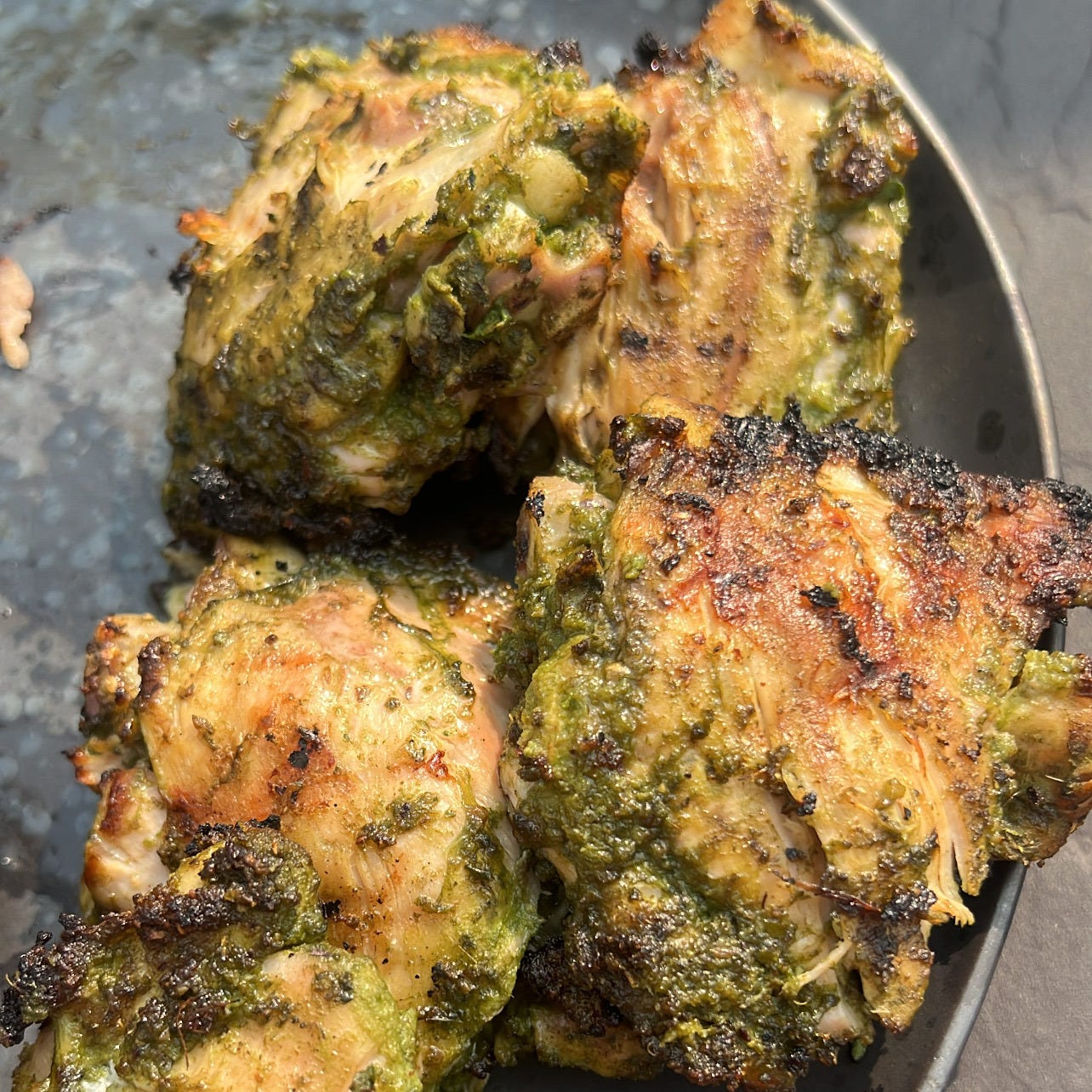Wandering solo around the streets of Edinburgh, I stumbled upon a pop up insect cafe. There in front of me laid out were pretty insect flour cakes, larva balls and roasted crickets tantalisingly glazed, herbed and smoked. I chatted to the owner Nahla, an ecologist who won an award for her cakes the National Scottish Baker of the Year Awards 2024/25 and bought a stash. It made me Google insect flour later and wonder whether people who aren’t enjoying insects as food already would take to it. Would you?
Insects have been bugging me since I got heckled for talking about our reliance on meat protein without a mention of them while speaking at a climate change event at the House of Lords recently. I left it out deliberately as it didn’t strike me as an easy concept to stomach for the audience in the room.
I am no nutritionist, but from what I understand, proteins are made up of a chain of amino acids and vital to the smooth running of the body and mind. Saying that, not all protein is equal. Complete proteins include all nine essential amino acids that the body needs but can’t produce on its own. Animals-based proteins are the best source, but soya is also included in this stellar tier.
We’re pretty attached to meat protein, for reasons including taste, preference and wealth. Meat consumption was going up steadily from the 1960s and then saw quite the spike from the 1980s. As a nation gets richer, its meat consumption goes up. This is terrible on several fronts. A study exploring the challenges noted three key risks - negative environmental impact, cardiovascular disease and some cancers and the likelihood of infections. It concluded:
The reduction of meat consumption should contribute to the reduction of GHG emissions and their considerable impact on global warming and climate change. It seems evident that human dietary habits regarding meat consumption in general, and red meats and wild meats in particular, should be significantly modified downward, as much and as soon as possible.
Just to clarify, we’re not the only ones consuming protein. The animals we keep and eat also have it in their diets. And not all sources of protein are equal. There are also near complete and incomplete sources of protein, which give us some but all the amino acids needed. The race is on, in labs, institutes and more to find better sources of protein. This is where insect protein steps in.
Many insects have high protein content of around 40%–75% with higher digestibility and are a good source of vitamins B1, B2, and B3, iron, and zinc (Belluco et al., 2013; Klunder, Wolkers-Rooijackers, Korpela, & Nout, 2012). Usually, insects have lipids with high amounts of unsaturated fatty acids than saturated fatty acids, besides carrying several minerals such as iron, calcium, potassium, phosphorus, zinc, magnesium, manganese, sodium, and copper and vitamins such as riboflavin, pantothenic acid, and biotin (Lamsal, Wang, Pinsirodom, & Dossey, 2019; Payne, Scarborough, Rayner, & Nonaka, 2016)
They are also a much more sustainable source of protein! They can be farmed locally, eat pretty much anything so help with food waste and don’t drain water or land resources. Let’s not have Global North blinkers on about the whole thing either. There are plenty of nations where insects are already enjoyed as food including China, Thailand and Mexico. In fact, over 150 countries enjoy entomophagy or insect eating.
Exciting things are already happening with insects elsewhere. Singapore has recently approved 16 varieties for human consumption, including silk worms and locusts. The Guardian reports the UK is lagging behind Europe, where the market is being reported as a “turning point in history”. Safety is an obvious concern. But there’s a more relevant blocker for those of us who are not taken by the idea yet.
It’s called the “yuck factor”. Crunchy creepy crawlies simply don’t have the epicurean appeal they need to make waves on many plates yet. London’s Borough Market has been selling them at their Raya stall for about six months, but I’m yet to grab a handy snack pack.
Nahla’s cakes led with insect as the key ingredients and were terrific. Domestic crickets baked into hibiscus and berry cake and little bundts with sweet potato, turmeric and mealworms were effortlessly delicious. I resisted the urge to leave with a pouch of roasted snacking crickets. The insect flour was spenny at £15 for a small pouch, but then Nahla grows her own and it’s a small business that’s yet to reach scale. The flour would be great in smoothies, soups, snack bars and savoury bakes.
Seeing insects on the high street and normalising them in food might well be the way forward. I’m keen to try Yum Bug, a new London restaurant that centres crickets on the menu and is reportedly excellent. Some of my followers tried insects on their travels and cricket mince, and enjoyed them. Others might be persuaded if they’re in benign powder format. Either way, they need to stop making our skin crawl and stomachs churn. The potential in them is far too delicious for that.
If you’ve tried them already, please share your thoughts!
Other things to eat…
I’ve been busy sharing recipes in print and online lately. Here’s a few that might come handy:
A deep dive into Butter Chicken for National Geographic Travel UK, with my all weather, home kitchen friendly version. Contrary to what a lot of people think, we we don’t eat this at home every day. It’s a North Indian restaurant dish that needs a tandoor or clay oven to cook!
A closer look at Raita, the refreshing yoghurt and vegetable chutney, that graces the plate of daily meals in many south Asian homes. The piece for Juggernaut includes two recipes from me - one for classic cucumber raita and the other for a more unusual egg raita (behind a paywall, soz)
Goan Chicken Cafreal, a heady, herbed chicken that is normally dry roasted that I popped on a BBQ at a friend’s soiree. Coconut vinegar gives it that authentic tang. Recipe on my Instagram, in the caption, but I’ve popped it below for you too.
Sweet, sticky and spicy courgette and aubergine skewers with Gochujang. I make these annually when the veg are at their best so it’s a bit of an oldie and goldie. On the Instagram again, but below too.
Goan Chicken Cafreal
Feeds 6
1 kg chicken thighs, skinless and boneless (6-9)
1 tbsp vegetable oil
Salt to taste
Marinade
100gm fresh coriander leaves and soft stalks
4 cloves garlic
2 inches ginger
3-4 green finger chillies
1 tbsp coriander seeds
1 tbp cumin seeds
2 inch cinnamon stick
2 cloves
3 tbsp Coconut Vinegar (apple cider will do)
Blitz the marinade ingredients into a smooth paste in a blender using a little water. You can dry roast the coriander, cumin, cinnamon and cloves until they are fragrant to intensify the flavour and make them easier to grind.
Add salt now to your taste and marinade the chicken with the paste. I use a ziplock bag but a bowl or lidded container will work just fine. Mix in the oil just before cooking on the BBQ for half an hour turning from time to time.
In the event of rain, these are just as good grilled, oven baked or sautéed without the addition of water.
Sweet, sticky and spicy veg skewers
Cut the courgettes and aubergines into 1cm half moons. Salt the aubergines for two hours, and the courgettes for an hour and drain. The marinade is 2 tbsp Gochujang for every tbsp of soya sauce, honey and 1 tsp of Sichuan Peppercorns. You can add a few drops of oil but it doesn’t need it to be honest.
Grill/griddle at home or barbeque until sizzling and golden.








I have eaten them - mainly crickets and ants. And would continue to do so as long as palatable. Texture can be an issue - crunchy food, squishy absolutely not. And how they are farmed. Like most things their flavour is very much dependent on what they eat. I have tried to view them as the land equivalent of shrimp and prawns with varying degrees of success.
In a world where beans and tofu exist, it's a no from me 😂